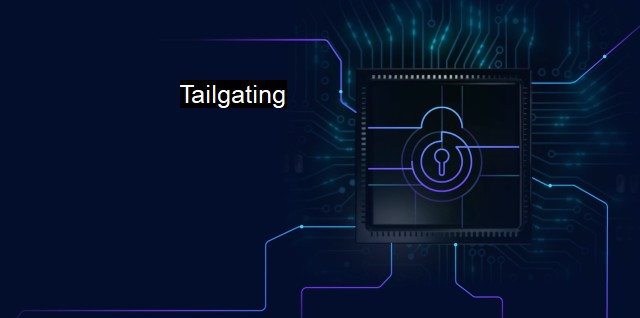What is Tailgating?
The Underrated Threat: Investigating Tailgating - A Form of Social Engineering that Bypasses Cybersecurity Measures
Tailgating, also known as piggybacking, refers to a phishing attack that takes advantage of close, legitimate interactions between people or systems to infiltrate networks, systems or facilities illegally. It's commonly used to describe the scenario where an unauthorized person physically follows or digitally navigates behind an authorized person to gain unauthorized access to restricted areas. Tailgating is a significant concern for the field of cybersecurity, since the hacker doesn't strain to avoid security measures but uses valid credentials or connections to maneuver past defenses undetected. This primarily involves human manipulation through deception and pretense.Malicious actors use tailgating in various methods to deceive their targets and gain unauthorized access. A typical example in a physical sense is when a person unbeknown to security personnel pretends to be an employee and follows behind an employee entering a secure area. Digitally, an unauthorized person might imitate an official website's login portal and lie in wait for unsuspecting targets to input their credentials voluntarily. The hacker then leverages the valid credentials to gain unintended access to systems or data, under the disguise of the initial, legitimate user.
Antivirus software and other security measures such as firewalls and encrypted algorithms can make it challenging for malicious actors to gain access to restricted areas or information. tailgating does exploit what is perceived as the weakest link in any security setup — the human element. While an antivirus solution can thwart attempts to infiltrate a computer system via malware, trojan horses, and other digital attack strategies, it falls short in combating trickery or deception targeting human intervention.
For instance, an actor might impersonate an official email, request a user to click a link to a 'login portal' that mirrors an official one. By relying on security ignorance or naivety of the targeted individual, the attacker can retrieve the unwittingly volunteered information, bypassing traditional security measures entirely. Cybersecurity criminals have achieved their objectives not because their software was superior but because a person was misled into clicking or act without cautious authentication of what was being perceived as legit.
It reinforces how pivotal human behavioral factor is in maintaining a robust security scheme. Most cyberattacks, specifically tailgating, can get thwarted right from the engagement level if people become more vigilant and attentive. This involves educating personnel on potential cybersecurity risks and setting up protocols when interacting with unidentified requests or suspicious digital correspondences. There's power in suspicion — teaching users to mistrust unusual request, cross-check information and refrain from divulging private or secure information without verification.
Integrating policies such as only one person with their respective specific credentials should access a specific restricted environment at a time can limit or prevent tailgating. Further security measures that can be utilized may include face recognition, coded cards, fingerprint sensors among others. These should govern entry to physical facilities consequently minimizing physical tailgating risks.
Enforcing stricter policies for secure channels and VPNs and implementing multifactor authentication strategies for digital assets like websites, platforms, or programs can significantly curtail digital tailgating attempts. It extends the concept of inaccessibility beyond mere passwords and usernames to include things only the valid user should have, like devices and one-time pad codes, or even what only a valid user would know, like the correct response to a personal or behavioral challenge.
To summarize, tailgating is a deceptive infiltration method employed by malicious actors intending to bypass security regulations by exploiting largely the human element. It is crucial to invest in physical and digital defenses to ensure restricted information remains concealed. Completely eradicating tailgating risks might be far-fetched but through employee education, strict security policies and advances in technology detection capabilities it can get controlled. Achieving a cutting-edge tailgating deterrent strategy requires a balanced amalgamation of human and digital defenses. The key is not only being cautious and suspicious but also being regularly updated, receptive, and conversant with evolving and upcoming security threats and countermeasures.

Tailgating FAQs
What is tailgating in cybersecurity?
Tailgating is a social engineering attack in which an unauthorized person follows an authorized person into a restricted area or system without proper authentication.How does tailgating work in cybersecurity?
In tailgating attacks, the attacker waits for someone with authorized access to a restricted area or system to enter, and then follows closely behind them before the door or system closes.What are the risks of tailgating attacks in cybersecurity?
Tailgating attacks can lead to data breaches, theft of sensitive information or intellectual property, and compromise of the organization's security posture. Unauthorized access can also result in insider threats, social engineering and phishing campaigns, and malware infections.How can you prevent tailgating attacks in cybersecurity?
To prevent tailgating attacks, it is important to establish policies and procedures for access control, increase awareness of social engineering tactics, and enforce strict physical security measures. This can include implementing multifactor authentication, installing CCTV surveillance, conducting security awareness training, and creating a culture of security awareness.| | A | | | B | | | C | | | D | | | E | | | F | | | G | | | H | | | I | | | J | | | K | | | L | | | M | |
| | N | | | O | | | P | | | Q | | | R | | | S | | | T | | | U | | | V | | | W | | | X | | | Y | | | Z | |
| | 1 | | | 2 | | | 3 | | | 4 | | | 7 | | | 8 | | |||||||